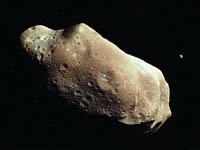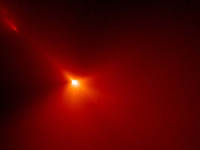 Exploring
Space, Page 2 of 6
Exploring
Space, Page 2 of 6
|
|

|
|
The
asteroid Ida and its newly-discovered moon Dactyl, photographed by
NASA's
Galileo
spacecraft. Ida is about the size of a large
city. [
Click
for a larger image.] Photo: NASA.
|
By chance, ground zero is the Canadian prairie, and the meteorite (as it's now called) smacks into the earth with the force of nearly one million megatons of TNT, carving out a crater ten miles across and several thousand feet deep. The enormous force of the impact momentarily compresses the ground, which springs back like a rubber handball, releasing a catastrophic explosion of dust, melted soil, and gases. The energy released from the impact heats the atmosphere, and grasslands and forests as far south as the equator burn to the ground within hours. Most of the meteorite is vaporized, and dust from the impact is thrown into the stratosphere, blocking the sun and dropping global temperatures about 18 degrees Fahrenheit. Photosynthesis is virtually halted; plants wither, and the animals that depend on them perish. For up to a year, farming is futile and mass starvation sets in. Cockroaches, rats, and other detritus-feeders survive and prosper on the decaying plants and animals.

|
|
|
Comet
Hyakutake was discovered in 1996 by an amateur astronomer in Japan
using only binoculars. The comet put on a spectacular display that
year, becoming the brightest comet in 20 years. [
Click
for a larger image.] Photo: NASA.
|
![]() ound
like the doomsday script of the newest Hollywood blockbuster? It's actually
a probable scenario built upon the prediction that a cosmic collision
may be in our near future. On March 11, 1998, Brian G. Marsden of the
Minor Planet Center at the Harvard-Smithsonian International Astronomical
Union made that startling announcement. In a press release, he reported
that in the year 2028, an asteroid called 1997 XF11, discovered by Jim
Scott of the Spacewatch program at the University of Arizona, would pass
within 30,000 miles of the earth, the width of a cat's whisker in astronomical
terms. The preliminary orbital calculation was based on observations made
by three additional astronomers, and Dr. Marsden stated that, although
the chance of a collision with earth was small, it was not out of the
question. In his announcement, Marsden, a respected expert in the field,
appealed to the astronomical community to search their photographic archives
for more observations of the asteroid, with the hope of determining the
object's exact orbit.
ound
like the doomsday script of the newest Hollywood blockbuster? It's actually
a probable scenario built upon the prediction that a cosmic collision
may be in our near future. On March 11, 1998, Brian G. Marsden of the
Minor Planet Center at the Harvard-Smithsonian International Astronomical
Union made that startling announcement. In a press release, he reported
that in the year 2028, an asteroid called 1997 XF11, discovered by Jim
Scott of the Spacewatch program at the University of Arizona, would pass
within 30,000 miles of the earth, the width of a cat's whisker in astronomical
terms. The preliminary orbital calculation was based on observations made
by three additional astronomers, and Dr. Marsden stated that, although
the chance of a collision with earth was small, it was not out of the
question. In his announcement, Marsden, a respected expert in the field,
appealed to the astronomical community to search their photographic archives
for more observations of the asteroid, with the hope of determining the
object's exact orbit.
|
|
|
|